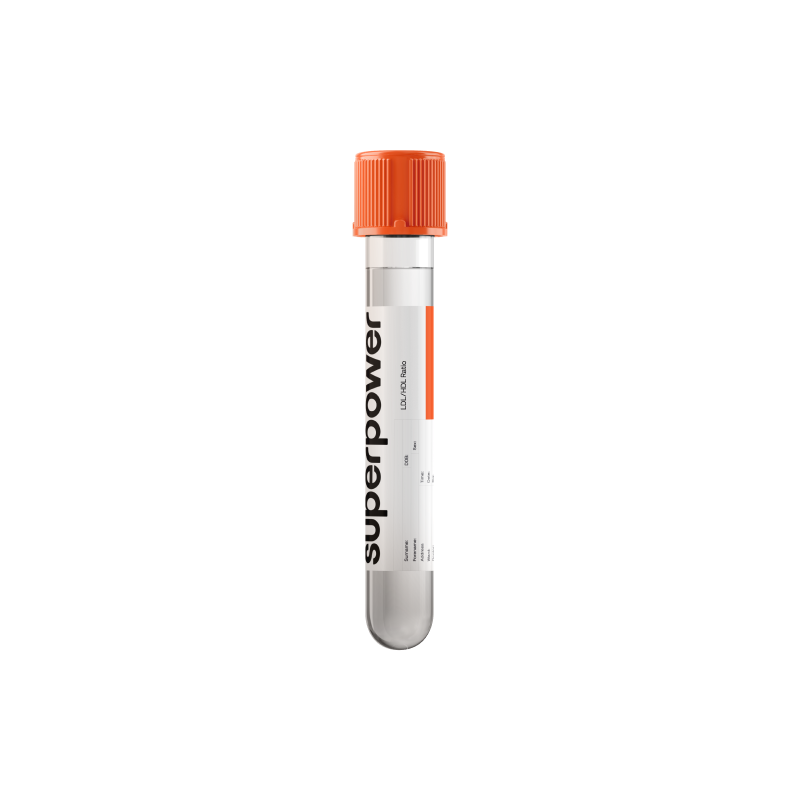This simple ratio reveals whether cholesterol balance tilts toward atherogenic risk or heart-protective clearance.
Tracking it helps clarify cardiovascular risk, guide lifestyle and therapy changes, and show progress over time.
Key Benefits
- Check the balance of 'bad' to 'good' cholesterol to gauge heart risk.
- Spot an unfavorable ratio that signals higher heart attack and stroke risk.
- Guide personalized lifestyle changes and statin decisions to lower lifetime heart disease risk.
- Clarify risk when individual LDL or HDL numbers seem borderline or conflicting.
- Protect fertility planning by flagging lipid imbalance common in PCOS and insulin resistance.
- Support pregnancy health by optimizing lipid balance before conception and during prenatal care.
- Track progress from diet, exercise, or medications by monitoring ratio trends over time.
- Best interpreted with a full lipid panel, non‑HDL cholesterol or ApoB, and risk factors.
What is LDL/HDL Ratio?
The LDL/HDL Ratio compares the amount of cholesterol carried by LDL to the amount carried by HDL in your blood. LDL (low-density lipoprotein) particles are produced and remodeled by the liver and intestine; they mostly arise when VLDL (very-low-density lipoprotein) sheds triglyceride and becomes cholesterol-rich. HDL (high-density lipoprotein) particles are formed in the liver and intestine and mature in the circulation as they collect cholesterol from cells. The ratio simply expresses how these two lipoprotein fleets relate to each other at a given time.
What it reflects is the prevailing direction of cholesterol traffic. LDL delivers cholesterol outward to tissues, while HDL retrieves it for return to the liver and disposal (reverse cholesterol transport). The LDL/HDL Ratio therefore condenses this tug-of-war into a single number, indicating the balance between cholesterol delivery and clearance from the bloodstream and artery walls (atherosclerotic plaque environment). It helps summarize the lipoprotein milieu that influences whether cholesterol tends to accumulate or be removed in vascular tissues.
Why is LDL/HDL Ratio important?
The LDL/HDL ratio captures how the body balances cholesterol delivery (LDL) with cholesterol removal and recycling (HDL). It is a snapshot of arterial traffic: more LDL relative to HDL tends to load cholesterol into artery walls, while more HDL helps clear it. This balance strongly predicts plaque formation, vessel stiffness, and downstream risks to the heart, brain, kidneys, and sexual function.
In many reports, population ratios often cluster around the low-to-mid 2s up to the mid 3s; lower values are generally more favorable. The ratio itself causes no symptoms, but as it worsens people may notice exertional chest pressure, calf pain with walking, erectile dysfunction, or brief neurologic symptoms from impaired blood flow.
When the ratio is lower, it usually reflects either lower LDL, higher HDL, or both. Physiologically that means less lipoprotein entry into the vessel wall, more reverse cholesterol transport, and a calmer endothelium. Most people feel fine. Very low ratios can occur with unusually low LDL (e.g., hyperthyroidism, malabsorption, certain genetic variants) or very high HDL; rarely, extremely high HDL may be less protective if the particles are dysfunctional.
A higher ratio means LDL predominates over HDL, favoring LDL oxidation, foam cell formation, and plaque growth. Men often run higher ratios than premenopausal women; ratios tend to worsen after menopause. In youth, a markedly high ratio suggests possible familial hypercholesterolemia. During pregnancy, lipids rise physiologically and the ratio may transiently increase.
Big picture: the LDL/HDL ratio integrates lipid physiology with inflammation, insulin resistance, thyroid and liver status, and genetics. Tracked over time, it complements non-HDL cholesterol and apoB to gauge atherosclerotic risk and long-term outcomes like heart attack and stroke.
What Insights Will I Get?
LDL/HDL ratio compares cholesterol carried to tissues (LDL) with cholesterol carried away for disposal (HDL). It is a systems marker of lipoprotein balance that integrates liver function, insulin signaling, thyroid status, inflammation, and sex hormones. Because it reflects both delivery and clearance, it tracks arterial plaque formation and endothelial health that influence cardiovascular risk, brain perfusion, kidney and sexual function, and aspects of immune response.
Low values usually reflect a low atherogenic load and/or robust reverse cholesterol transport. This often occurs in metabolically flexible states, in premenopausal women, and with certain genetic patterns that raise HDL. Very low ratios can also appear with hyperthyroidism, malabsorption, chronic illness, or undernutrition, where LDL production falls.
Being in range suggests balanced lipid trafficking with stable plaque dynamics and preserved endothelial nitric oxide signaling. It generally indicates better insulin sensitivity and quieter inflammation. Consensus favors ratios toward the lower end of the reference interval as more protective, provided they are not driven by acute illness.
High values usually reflect excess LDL relative to HDL, indicating impaired clearance, increased hepatic VLDL output, or both. Common drivers include insulin resistance, visceral adiposity, low thyroid hormone, nephrotic-range protein loss, chronic inflammation, androgen exposure, and familial hypercholesterolemia. Ratios tend to rise with age and after menopause, paralleling higher atherosclerotic risk.
Notes: Ratios shift during pregnancy (LDL and HDL both rise; interpretation differs by trimester). Acute infections lower HDL more than LDL, transiently increasing the ratio. Nonfasting samples and high triglycerides can distort calculated LDL, affecting the ratio. Medications that alter lipoproteins (e.g., estrogens, androgens, glucocorticoids, statins) change the ratio. Use age- and sex-appropriate references.



.svg)



.png)
.png)
.png)
.png)








